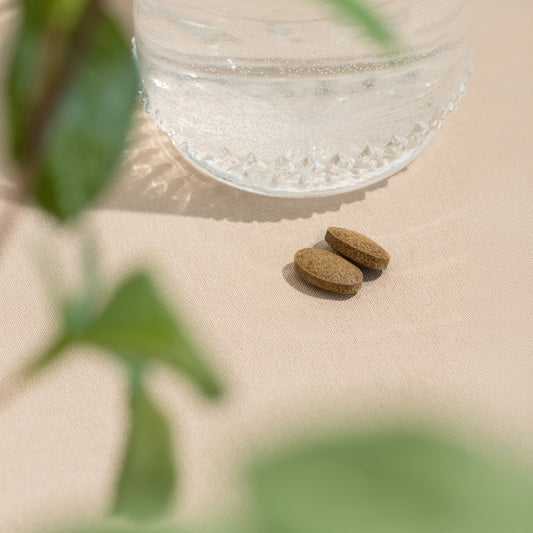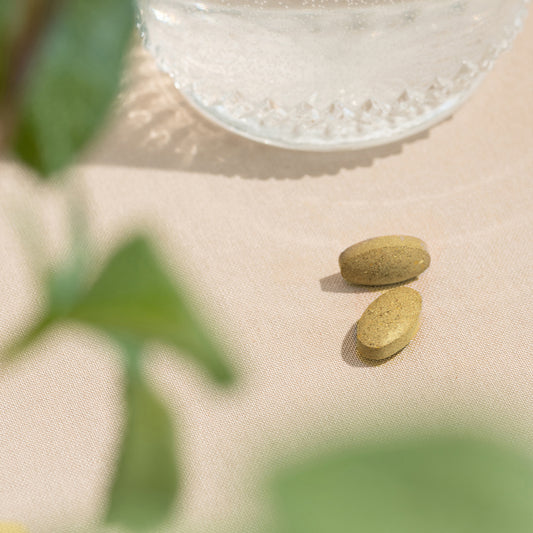Allergy Free
An Ayurvedic Perspective on Allergies

Do you suffer from allergies in any way? Perhaps you've come to dread the arrival of springtime because of the degree to which your allergies overtake your life. Unfortunately, many of us feel utterly helpless when it comes to changing our allergy experience in any real or meaningful way.
But because they so commonly flare up at this time of year, spring is an especially poignant time to explore the
In this article:
- Allergies and the Three Doshas
- General Therapeutic Strategies for Allergies
- Many Paths, One Objective
According to Ayurveda, an allergy is the result of a particular substance (the allergen) aggravating a specific dosha: vata, pitta, or kapha.
More often than not, allergic reactions are reflective of our constitutions. In other words, a
However, it is also possible to develop allergies that do not correlate with our constitutions. For instance, a
Allergies and the Three Doshas
Below, you will find a description of allergies according to dosha: vata-type, pitta-type, and kapha-type—each with a brief exploration of the classic symptoms, potentially aggravating foods, and a short list of dosha-specific remedies.
This information provides an important foundation. But there is no need to feel bogged down by these details because, next, we'll look at a number of Ayurvedic tools that can reduce allergy symptoms—regardless of their origins.
Vata-Type Allergies
Vata types of allergies are often experienced in the digestive tract with symptoms such as burping, bloating, digestive discomfort, gas, gurgling intestines, vague abdominal pain, and intestinal colic. They can also include symptoms of constriction such as wheezing or headache, as well as sneezing, ringing in the ears, joint pain, sciatica, muscle twitching or spasms, insomnia, nightmares, and other vata-type discomforts.1
Possible Correlation with Vata-Aggravating Foods
Vata imbalances can cause food sensitivities to raw foods, many beans (black beans, pinto beans, adzuki beans, etc.), and certain animal proteins, like pork. These foods can also aggravate vata types of allergies.
Balancing Vata
When vata is aggravated, it is important to slow down, keep warm, stay hydrated, and eat a vata-pacifying diet. Vata types of allergies are often soothed by warm herbal teas with an added drop of sesame oil or
Pitta-Type Allergies
Pitta types of allergies usually occur when the hot, sharp qualities of an allergen come in contact with the skin and then subsequently enter the bloodstream. Pitta-type allergies are therefore often skin-based reactions such as hives, rashes, itching, allergic dermatitis, eczema, and may also involve bloodshot eyes. In the GI tract, pitta allergies can cause heartburn, acid indigestion, stomach upset, nausea, or vomiting. Pitta-type allergies can also induce hot flashes.2
Possible Correlation with Pitta-Aggravating Foods
High pitta can cause food sensitivities or allergies to hot, spicy dishes, citrus fruits, sour fruits, tomatoes, potatoes, eggplant, and fermented foods. These foods can also aggravate pitta types of allergies.
Balancing Pitta
When pitta is high, it is best to keep cool, to avoid exercising at midday, and to eat a pitta-pacifying diet. Cooling and cleansing herbs can also be supportive. Because pitta has such an affinity for the blood, purifying the blood is often tremendously helpful. Simply donating blood can pacify pitta in much the same way that traditional bloodletting does.3
For the Skin
To balance and soothe the skin, try one of the following therapeutic strategies:
Fresh Cilantro Juice
Drinking cilantro juice cools and calms the entire system and promotes optimal health, comfort, temperature, and fluid balance in the skin. Simply place a handful of fresh cilantro in a blender with about 1/3 cup water and blend. Strain the pulp and drink the juice.4
Cilantro Pulp
Applying fresh cilantro pulp directly to the skin offers more localized soothing support and can be used in conjunction with cilantro juice. The pulp can be applied to the skin after it has been separated from the juice.5
Kapha-Type Allergies
Kapha-type allergies are the most likely to be exacerbated during the spring season because of the onslaught of pollen-based allergens. Kapha allergy symptoms include irritation of the mucus membranes, hay fever, cold, congestion, cough, sinus infection, water retention, bronchial congestion, asthma, and even sleeping disorders.6 In the digestive tract, kapha types of allergies can create a certain heaviness in the stomach and sluggish digestion.
Possible Correlation with Kapha-Aggravating Foods
Elevated kapha can cause food sensitivities or allergies to dairy products like milk, yogurt, and cheese, and also to wheat, cucumber, or watermelon. These foods are also likely to aggravate kapha types of allergies.
Balancing Kapha
When trying to balance kapha, it is best to keep warm and dry, to avoid daytime napping, to stay active, and to eat a kapha-pacifying diet. Drinking lightening and clarifying herbal teas can also help liquefy, dry, and eliminate excess kapha.7 Using small amounts of local honey as a sweetener serves to cleanse the system of excess kapha and can also help diminish sensitivity to local pollens.
In addition, warm and stimulating herbs can help clear excess kapha from the chest and stomach, promote proper fluid balance in the tissues, and restore strength to a sluggish digestive fire.
If you tend to struggle with springtime allergies in particular, a dietary cleanse at the junction between winter and spring can help clear the stomach and lungs of the excess kapha that is usually at the root of kapha types of allergies. Throughout the rest of the spring, a weekly one-day fast—whether a total fast, a fruit or juice fast, or a mono-diet of kitchari—can help keep kapha balanced.8
There are also more advanced Ayurvedic therapies, like panchakarma, that offer a powerful means of clearing accumulated kapha from the system. These are best done under the guidance of an Ayurvedic practitioner.
General Therapeutic Strategies for Allergies
While identifying the type of allergy you suffer from is an important first step, there are a number of treatment strategies that can be helpful no matter which dosha is at the root of your particular allergy. These therapies can complement any dosha-specific strategies you might be using and, because they are universal, often help improve our baseline sense of wellness at the same time.
Avoid the Allergen
As obvious as it may seem, avoiding exposure to a particular allergen can give your body an important rest from the over-active immune response at the root of your allergy. If you're allergic to pollen, do your best to stay out of its way for a while. If you're allergic to cat dander, try to avoid all contact with felines for a bit.
It can also be helpful to dress in cotton clothing (which is fantastically hypo-allergenic, especially if the fiber is organic and was produced free of pesticides). If possible, avoid contact with synthetic fibers like polyester or rayon.
Support Strong Digestion
Ayurveda places a huge emphasis on the health of the digestive system. Digestive strength is intricately linked to the immune response, so clearing out and firing up the digestive capacity can be tremendously helpful when it comes to allergies.
To support your digestion (agni), minimize your intake of stimulants, refined sugars, and processed foods. It is also helpful to eat with mindfulness, follow a consistent mealtime schedule, and incorporate
Prioritize Proper Food Combining
Again, because the digestive tract and immune function are so intricately linked, proper food combining can provide essential support by helping improve digestive health. This, in turn, can bolster immune health.
Ayurveda outlines a number of foods that, while perhaps fine to eat separately, are incredibly taxing to digest in combination with one another. These include things like meat and dairy, milk and yogurt, beans and cheese. For a more complete understanding of how to approach this strategy, please see our resource on proper food combining.
Follow a Dosha-Pacifying Diet
This will vary, depending on the dosha most prominently at play in your allergic response. If you have more kapha types of symptoms, follow a kapha-pacifying diet. If pitta is the major player in your allergic response, follow a pitta-pacifying diet. And if your symptoms point to vata types of allergies, follow a vata-pacifying diet.
Undertake a Dietary Cleanse
Given the profound connection between digestion and immune function, stoking the digestive fire with a cleanse can be an incredibly powerful way to support the immune system and minimize the development of allergies.
The basic premise of a cleanse is that our bodies are inherently intelligent; when we provide a break from the barrage of potentially harmful inputs, our bodies immediately allocate the extra energy to cleaning house—repairing and rejuvenating the system for optimal performance.
A dietary cleanse can help reset the digestive system in much the same way that restarting a computer helps eliminate glitches and idiosyncrasies that can interfere with routine functioning. Cleanses help clear toxins, balance the doshas, and kindle a stronger digestive fire—all of which will support digestive health, proper immune function, and fewer allergies.
Cleanses can be as simple as a half or full-day fast, a short juice cleanse, or a longer mono-diet of something like kitchari. Ayurveda offers a number of effective cleansing techniques. If you are intrigued and would like some guidance, please see our Cleansing Department, where we outline several different types of Ayurvedic cleanses.
Cleanse or Lubricate the Nasal Passages
Because the respiratory system is a common host to allergic symptoms, offering some direct support to the nasal passages can help mitigate the impact of allergens on these delicate tissues. Nasya and neti pot both support clear breathing and a clear mind, but their effects are quite different.
The descriptions below will help you decide which one would be best for you. Or, you can experiment with both and decide which you like better. Because these therapies introduce somewhat opposing energies, they are best practiced separately. It may be that one is simply a better fit for you. But if you like them both, you can alternate by day, by season, or by symptom—according to what works best for your body.
Nasya
Lubricating the nasal passages is also said to improve the quality of the voice and to strengthen vision. Nasya should not be performed during menstruation or pregnancy. If this practice is new to you, please watch our short instructional video.
Nasal Rinse
Nasal rinse, or
If you find that your nasal passages feel dry afterward, or if you want to create a barrier against potential allergens, you can use your pinky finger to lubricate the nostrils with a bit of oil—either immediately after neti pot, or at another time of day. If using a neti pot is new to you, please watch our short instructional video.
Gargle with Supportive Liquids
If the throat is aggravated, gargling with either a bit of honey in hot water or with a mix of 1 cup hot water with 1 teaspoon turmeric powder, and 1 teaspoon natural mineral salt can be both clarifying and soothing.9
Meditate to Reduce Stress
Most allergies can be linked to stress.10 Ayurveda recognizes the power of a number of subtle therapies that can help reduce the detrimental impacts of stress on the physiology. Meditation is a very effective technique; it helps minimize our experience of stress and also encourages the development of more constructive responses to stressful situations.
Even ten to fifteen minutes of daily meditation can have a profound impact on your state of mind. If you do not already have a meditation practice, Empty Bowl Meditation, as taught by Vasant Lad, MASc, is a simple but powerful practice appropriate for most anyone.
Devote a Few Minutes Each Day to Pranayama
Pranayamais the practice of working with the breath to affect both gross and subtle aspects of the mind-body organism. Like meditation,
In addition, pranayama offers more specific support to the respiratory passages so often impacted by allergies. Here are a few breathing practices to consider:
Alternate Nostril Breathing
This practice, also known as Nadi Shodhana, is wonderful for reducing stress and supporting balance throughout the respiratory
Ujjayi Breath
Ujjayi Pranayama activates the throat center and helps balance the entire energetic body. It also offers powerful support to the immune system.
Bhastrika (Bellows Breath)
Bhastrika Pranayama is an invigorating practice that creates internal heat, helps liquefy excess mucus, and generally clears obstructions from the respiratory system. It is particularly beneficial for congestive types of allergies.
Practice Yoga
Sun Salutations
Sun Salutations (Surya Namaskar) are warming, activating, invigorating, and also grounding. Because they encourage the development of internal heat, sun salutations are most appropriate for vata and kapha types of allergies.
Moon Salutations
Moon Salutations (Chandra Namaskar) are cooling, soothing, grounding, and calming. Because they slow and cool the system, moon salutations are more appropriate for pitta types of allergies.
Many Paths, One Objective
One of the things that is most inspiring about Ayurveda is its ability to heal each individual—according to his or her particular needs. For every ailment, Ayurveda offers many effective treatment strategies.
As we have seen, this is certainly the case with allergies. In truth, the symptom isn't the most important factor in determining the best therapies to pursue. The individual is. That means that you… YOU (and your particular constellation of constitution, imbalance, diet, lifestyle, etc.) are the most critical piece of information in determining which therapies would be most supportive in your individual case.
This is why working with a trained Ayurvedic practitioner can be so immensely rewarding. This aspect of Ayurveda is also an invitation for you in your own healing process. It is an opportunity to sit with your situation, to contemplate the many factors at play in your imbalance, and to explore—from that thoughtful place—which healing modalities are most likely to address and heal the root of your particular imbalances.
The options we've laid out for you above might feel overwhelming at first. But in reality, each of us has a different sweet spot—a unique entry point that, when accessed, will allow for deeper healing.
For some, the opening for positive change lies in tweaking the diet. For others, it's just the right herb, a perfectly matched pranayama, a contemplative practice, or a combination of tools that creates an ideal space for healing.
Ayurveda is not a quick-fix or a silver bullet approach. But the tradition has stood the test of time for over five thousand years and continues to help and inspire people around the world.
While it may take a little effort to find your path toward balance—your unique avenue toward allergy relief—this is a powerful journey to be embarking on. For our part, we sincerely hope that we can support you along the way. Here's to a vibrant spring, some allergy relief, and a life marked by ever-improving health and wellness.
About the Author
Melody Mischke, AP
Melody Mischke is a certified Transformational Coach, Ayurvedic Practitioner, Yoga Teacher, Writer, and Intuitive. She began studying meditation in India at 18, and has...
More for You
Ayurvedic Food Combining
Proper food combining can improve the quality of your digestive health. Learn which food combinations Ayurveda recommends for optimal digestive wellness.
Empty Bowl Meditation
There are many meditation techniques, but Empty Bowl meditation is one that calms the mind, awakens kundalini shakti, and unfolds a blissful state of awareness.
References
1 Lad, Vasant. The Complete Book of Ayurvedic Home Remedies. New York: Three Rivers Press, 1998. Print. 118-119, 182.
2 Ibid.
3 Ibid, 119.
4 Ibid, 246.
5 Ibid.
6 Ibid, 118, 182.
7 Lad, Vasant. Textbook of Ayurveda Vol III: General Principles of Management and Treatment. Albuquerque: The Ayurvedic Press, 2012. Print. 113.
8 Ibid.
9 Ibid.
10 Lad, The Complete Book of Ayurvedic Home Remedies. 121.
11 Ibid.











